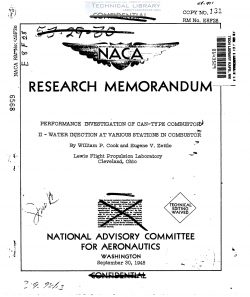naca-rm-e8f28
- Version
- 86 Downloads
- 1,008.14 KB File Size
- 1 File Count
- April 21, 2017 Create Date
- April 21, 2017 Last Updated
National Advisory Committee for Aeronautics, Research Memorandum - Performance Investigation of Can-Type Combustor - II - Water Injection at Various Stations in Combustor

An investigation was made to determine the maximum quantity of
water that could. be injected either into or ahead. of a single can-
type combustor without reducing the attainable combustor-outlet tem—
perature below the value required for engine operation and without
the appearance of liquid. water at the combustor outlet. The inves-
tigations were conducted at simulated conditions of military-rated
engine speed. of 7600 rpm, zero ram, and obtainable altitudes of
15,000 to 45,000 feet. Water was injected from spray nozzles at
each of four stations: (1) ahead of the combustor, simulating
injection ahead of the compressor in the engine; (2) into the
upstream end of the combustor; (3) into the combustor halfway along
its length; and (4) into the downstream end of the combustor.
The mazinm total liquid-air ratio attainable without reducing
the attainable combustor-outlet temperature below the required value
for engine operation with water injection at each of the four sta-
tions at an altitude of 50,000 feet was: 0.065 at station 1; 0.044 at
station 2; 0.097 at' station 5; and. "0.129 at station 4. With water
injection at stations 5 or 4, however, liquid water passed through
the combustor when the total liquid-air ratio exceeded a value of
about 0.07. The results indicated that water injection at or near
station 5 made possible the attainment of the highest total liquid-
air ratios for the conditions at which the required combustor-
outlet temperatures were attained and. no liquid water appeared at
the oombustor outlet.
Because a reaction motor has a low propulsive efficiency at”“
low airspeeds, means of augmenting the thrust on? some types of
reaction motor for take-off and power spurts during flight are of
interest. Various methods of augmenting the thrust of turbojet
engines are being investigated at the NASA Cleveland. laboratory.
Thrust augmentation can he obtained by an increase in mass flow
through the engine or by an increase in temperature that results in
a higher Jet velocity of the exhaust gases.
| File | Action |
|---|---|
| naca-rm-e8f28 Performance Investigation of Can-Type Combustor - II - Water Injection at Various Stations in Combustor.pdf | Download |

Comment On This Post